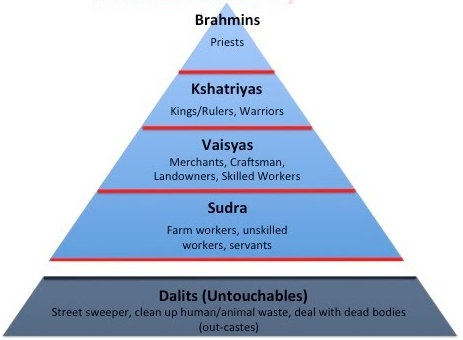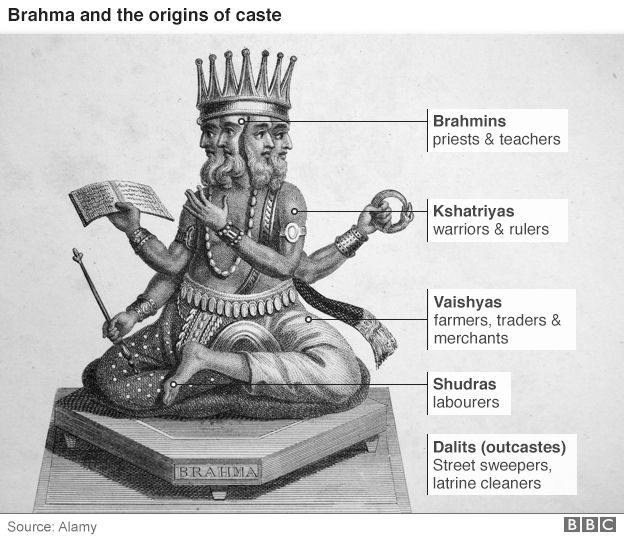Which Best Describes the Caste System in India
The BBC explains its complexities. Indias caste system is among the worlds oldest forms of surviving social stratification.

What Is India S Caste System Bbc News
The Varna system allows people to move from being a shudra to a brahmin depending on ones ability.

. In India there is an elaborate system of social classification called the caste system. Varna is another word to describe social classes. Which of these statements best describes Hinduism.
Asked Sep 3 2021 in Sociology by Victor. Explain how this quote choose a job you love and you will never have to work a day in your life - confucius is consistent with the beliefs of one of the ancient chinese philosophies. People can move freely between varnas.
It began with the unification of northern India by a single ruler and spread southward through future conquests. Hinduism features a trinity of three gods including Brahma Vishnu and Shiva. 2 on a question Which best describes the caste system in India.
On StudySoup on 5312017. The answer is A. DOutcasts could easily move up to.
Castes were fluid and people could move to a lower or higher caste based on their wealth and moral behavior. This 67 words question was answered by Heather L. Members of most castes could interact freely including eating together.
The caste system in India originated with the arrival of the Aryans in India around 1500 BC. The description that best describes the casting system in India is A method of Ranking people by social class One of the oldest forms of stratification is represented in the Caste System of ancient India. The caste system was and in some areas still isused to separate people into 5 groups these groups being from highest rank to lowest Brahmins basically priests kings and warriors merchantstraders laborers and lastly the untouchables.
Brahmin Kaptiyalkabtiyal Why is there a caste system in India. 2 Show answers Another question on History. CA person born into one caste rarely changed castes or mixed with members of other castes.
The state of not wanting anything. Castes are rigid social groups characterized by hereditary transmission of life style occupation and social status. It differs from jati because jati is the division into smaller communities and varna is still the four original caste groups.
Both jati and varna expresse communities i India. The caste system helped maintain order in a society without strong central government. India has a caste system because it is in their tradition.
AThe caste system was only in existence for a few hundred years. Log in for more information. A persons caste is an example of.
Which statement best describes the development of the Mauryan Empire. Its meaning is being a more common word used instead of caste. The caste system is mandated by Indias legal system and it dominates all aspects of professional and social life throughout the country.
This action however did not eliminate caste-based discrimination or social divisions based on caste. In the post classical era political economic and social changes challenged the caste system. 3 on a question.
Which statement best describes the caste system of ancient India. The only major restriction was on marrying together. Which description best describes the caste system in India.
Whereas Funan and Majapahit were Hindu kingdoms the religion that predominated in. Transformed by Indian history over the centuries especially by the Mughal Empire and the British Raj as a means of social control Indias caste system consists of two different concepts. Which of the following statements accurately describes Indias caste system.
The caste system of post classical times was more complex than in earlier periods. The caste system as it exists in India today was introduced by the British during their colonial rule to replace the ancient Varna system The word caste is based on the Portuguese word casta. Which of these.
The caste system consists of two different concepts varna and jati which. TheIndian caste system has been a part of Indian culture for hundredsof. The caste system in India has its origins in ancient India and was transformed by various ruling elites in medieval early-modern and modern India especially the Mughal Empire and the British Raj.
- best describes the role of the caste system in India today. In the Hindu trinity of gods what is Shiva. Which statement best describes the spread of Hinduism-Hinduism did not spread outside of its homeland in India-The spread of Hinduism had stopped by the beginning of the Vedic period-Hinduism spread throughout India and Nepal and into Southeast Asia-Beliefs of Hinduism changed greatly when it spread into the Middle East.
The caste system was outlawed in India in 1949. The caste system is a way of dividing society into hereditary classes. The lowest varna cannot associate with higher varnas.
Which of these represented the priest class in the early caste system in India. This has existed for thousands of years and still dictates to a great extent the social and economic status of an individual. The system which divides Hindus into rigid hierarchical groups based.
BSpiritual leaders called Brahmins made up the lowest caste. 50 points plz.

Indian Society And Bharatanatyam Bharatanatyam Indian Caste System History Of India


No comments for "Which Best Describes the Caste System in India"
Post a Comment